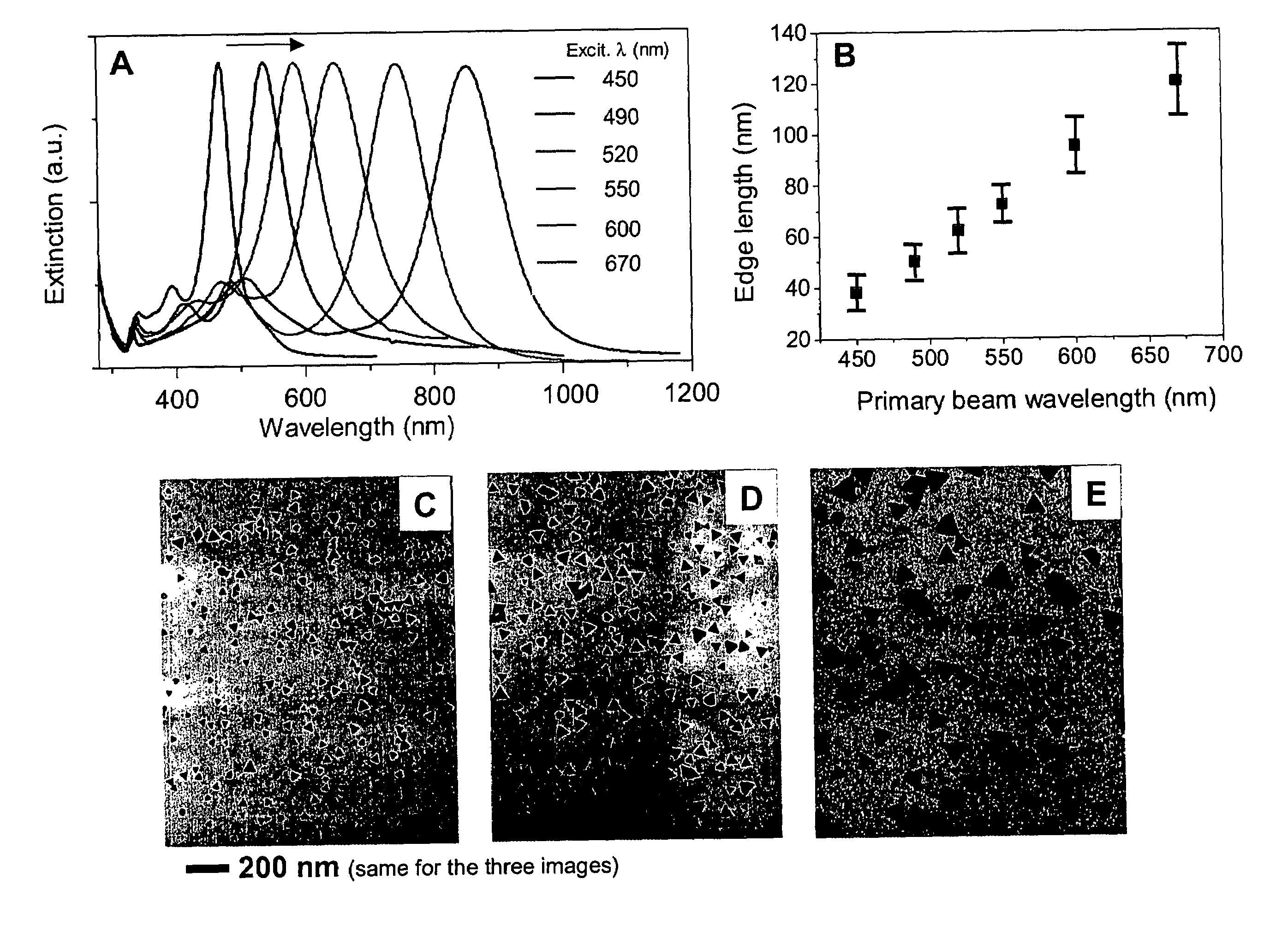Methods of controlling nanoparticle growth
a technology of nanoparticles and nanoparticles, applied in the field of nanoparticles, can solve the problems of unimodal particle growth and the method will fall outside the known ostwald ripening mechanism
- Summary
- Abstract
- Description
- Claims
- Application Information
AI Technical Summary
Benefits of technology
Problems solved by technology
Method used
Image
Examples
example 1
[0034]This example illustrates one method of making silver colloids suitable for use in the methods of the present invention. AgNO3 (99.998%) and NaBH4 (99%) were obtained from Aldrich, and bis (p-sulfonatophenyl) phenylphosphine dihydrate dipotassium (BSPP) was purchased from Strem Chemicals, Inc. All H2O was purified by a Barnstead Nanopure H2O purification system (resistance=18.1 MΩ·cm). 100 mL of nanopure H2O, 1 mL of 30 mM trisodium citrate, and 2 mL of 5 mM AgNO3 solution were mixed in a 250 mL three neck flask. The flask was immersed in an ice bath, and the solution was bubbled with argon under constant stirring for approximately 30 minutes. 1 mL of 50 mM aqueous NaBH4 (ice-cold, freshly made) was quickly injected into the solution under vigorous stirring. The clear solution immediately turned light yellow. The reaction was allowed to proceed for approximately 15 min, and 1 mL of 5 mM BSPP solution and a 0.5 mL aliquot of NaBH4 were added to the solution in a dropwise fashion...
example 2
[0035]This example illustrates the production of a nanoprism suspensions by the photo-initiated plasmon excitation means of the present invention. A xenon lamp (Novalight system, 150 W, light output approximately 12 W, Photon Technology, Inc.) was utilized as the light source for the photosynthetic experiments. Optical band filters (diameter=25 mm, band width=10 nm or 40 nm) were obtained from Intor, Inc. The photoconversion of nanospheres to nanoprisms was performed in a glass flask or quartz cell. The quartz cell was only used in double beam experiments when light less than 400 nm was introduced. The silver colloid was sealed in the reactor wrapped with aluminum foil. For the single beam excitation experiment, the 550±20 nm beam (green, approximately 100,000 Lux, measured with a digital light meter, Model LM-1, Family Defense Products) was introduced to the silver colloids through a hole (ca. 20 mm in diameter) on the aluminum wrap. The distance between the reactor and the light o...
example 3
[0037]This example provides a sample calculation of the temperature rise in the silver nanoparticles exposed to 550±20 nm beam excitation. The parameters for the silver colloid:
[0038]100 mL of silver colloid (silver atomic concentration=0.1 mM);
[0039]The volume of a Type 1 prism (edge length=70 nm, thickness=10 nm): 2.1×10−17 cm3;
[0040]The mass of a Type 1 prism=2.1×10−17 (cm3)×10.5 (g / cm3)=2.2×10−16 g;
[0041]The number of Type 1 prisms in 100 mL of colloid=4.8×1012;
[0042]The energy of a 550-nm photon=1240 (eV·nm) / 550 (nm)=2.25 eV=3.6×10−9 J
[0043]The 550-nm beam power approximately 0.2 Watt;
[0044]The 550-nm photon flux=0.2 (J / s) / 3.6×10−19 (J / photon)=5.6×1017 photons / sec;
[0045]Bulk silver specific heat capacity=0.235 J / g / K (CRC Handbook of Chemistry and Physics, 83rd ed., London, New York)
[0046]The heat capacity of a Type 1 prism=0.235 (J / g / K)×2.2×10−16 (g / particle)=5.2×10−17 J / K.
[0047]In the calculation, it is assumed that the absorbed photon energy is rapidly equilibrated among the ...
PUM
| Property | Measurement | Unit |
|---|---|---|
| wavelengths | aaaaa | aaaaa |
| wavelengths | aaaaa | aaaaa |
| diameter | aaaaa | aaaaa |
Abstract
Description
Claims
Application Information
 Login to View More
Login to View More - R&D
- Intellectual Property
- Life Sciences
- Materials
- Tech Scout
- Unparalleled Data Quality
- Higher Quality Content
- 60% Fewer Hallucinations
Browse by: Latest US Patents, China's latest patents, Technical Efficacy Thesaurus, Application Domain, Technology Topic, Popular Technical Reports.
© 2025 PatSnap. All rights reserved.Legal|Privacy policy|Modern Slavery Act Transparency Statement|Sitemap|About US| Contact US: help@patsnap.com



